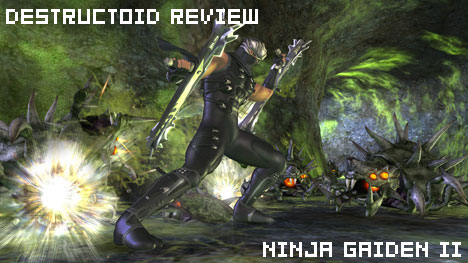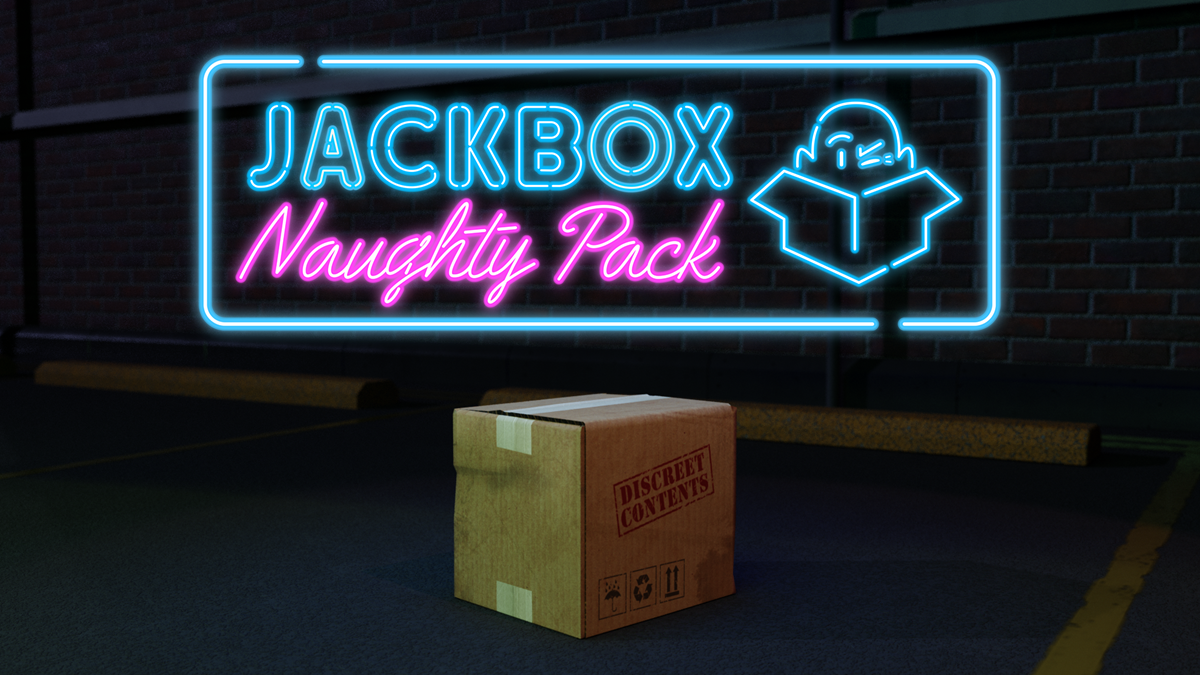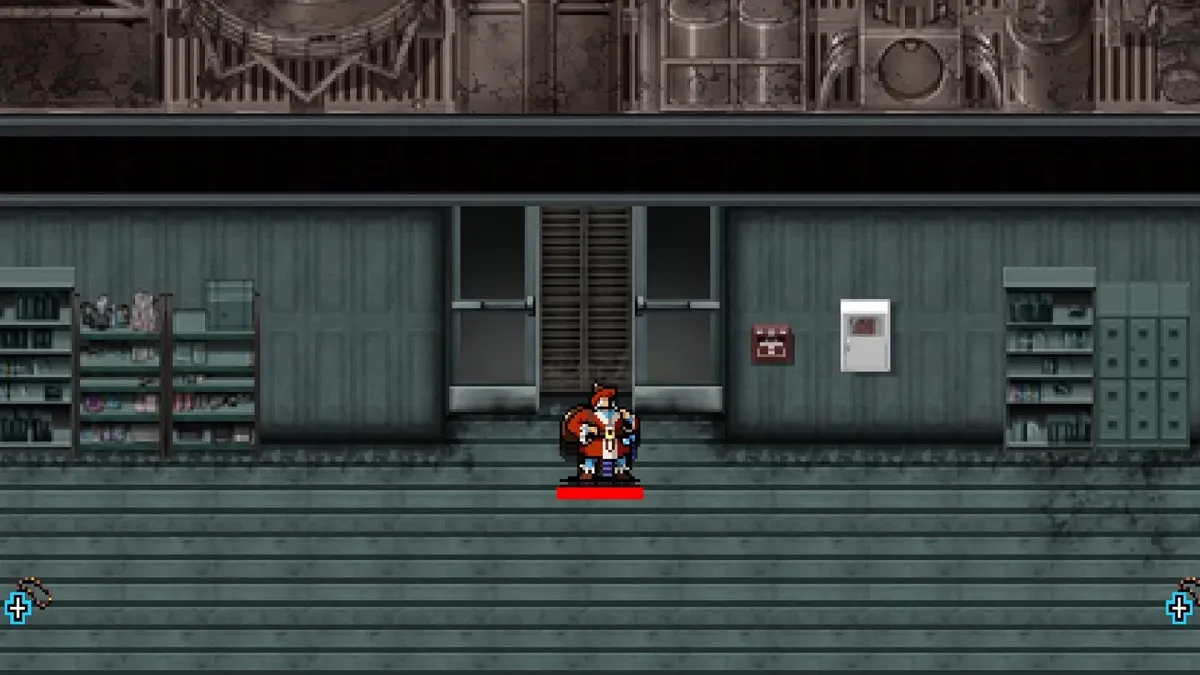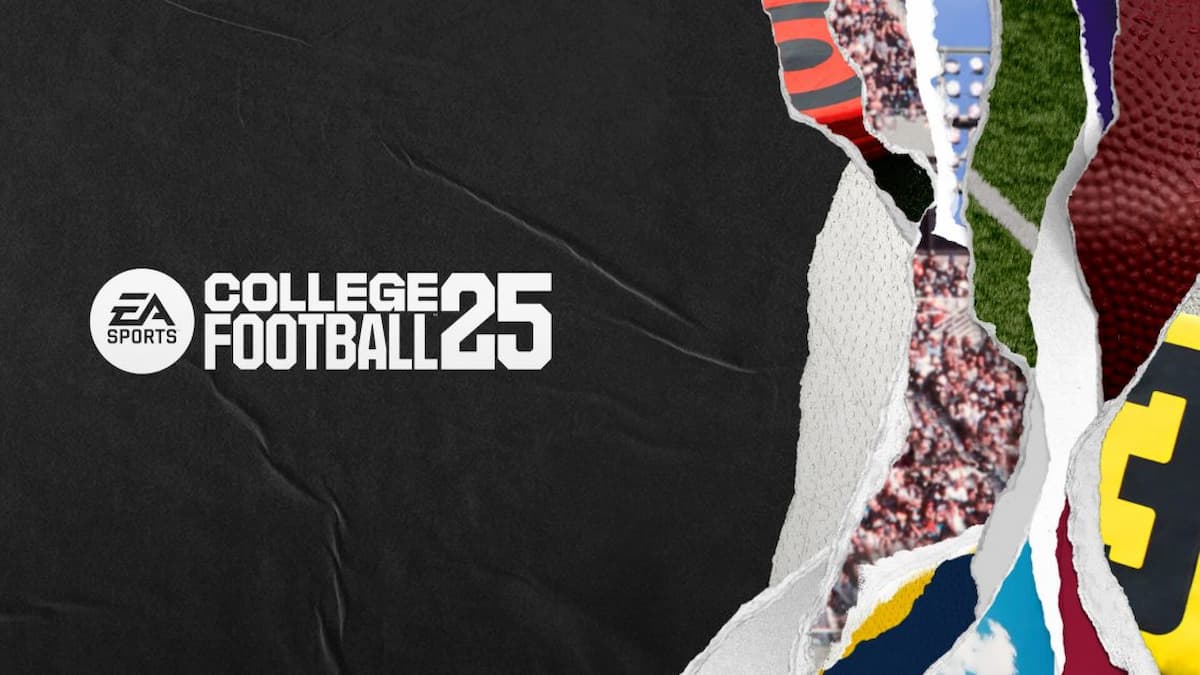Historically, ninja are known for their proclivity for stealth tactics: silently slipping into the fortresses of their enemies, dispatching them quietly, and leaving behind no trace. Evidently, Team Ninja didn’t get the memo. Their Xbox 360 exclusive, Ninja Gaiden II (the sequel to their 2004 ball-breaking Xbox action title), takes any notion of subtlety and jams a blade into its head before violently removing it with a scythe.
Ninja Gaiden II sets young ninja master Ryu Hayabusa on a path of vengeance, determined to put a stop to the Black Spider Clan, who have stolen an ancient artifact that threatens to destroy the human race. In the process, Ryu leaves a messy trail of bodies, slicing and dicing his way through 14 chapters of ninja, demons, and unfortunate military personnel and equipment. Ryu doesn’t quietly enter a room — he smashes through a stained glass window to thumping techno music.
The first game set a new bar for excellence, with smooth, intense combat, and awe-inspiring visuals that to this day impress. Does Ninja Gaiden II deliver the same kind of awesome Team Ninja brought to gamers some four years ago? Hit the jump to find out.
Ninja Gaiden II (Xbox 360)
Developed by Team Ninja
Published by Microsoft
Released on June 3, 2008
Like the original, Ninja Gaiden II’s fast-paced action is without equal in the genre. Ryu brings the death with a variety of combos that rivals most one-on-fighting games, including any one character found in Team Ninja’s own Dead or Alive series. With actions mapped to the X and Y buttons, you’re pulling off moves that make you feel like a bad-ass in no time, further enhanced by the game’s exaggerated violence. There’s no real trick to complete decimation of your enemies — it simply happens without much effort.
Nearly every battle in Ninja Gaiden II seems directly inspired from the Bride’s encounter with the Crazy 88 in Tarantino’s Kill Bill; outnumbered and surrounded, Ryu unleashes a wrath that results in dismemberment and plenty of crimson splattered along the walls and ground. Interestingly, Team Ninja actually ties this violence directly into the gameplay; removing an opponent’s arm, for instance, will cause the enemy AI to become more aggressive. Without limb and with “nothing to lose,” they’ll go into a frenzy that may end in them sacrificing themselves simply to extract revenge. This is where the game’s new finishing move — the Obliteration Technique — comes into play.

While it’s likely inspired by God of War’s violent Quick Time Event fatal blows, Ninja Gaiden II simply requires you to press Y when in close proximity of a mortally wounded enemy. Upon doing so, all hell breaks loose as Ryu performs a deadly series of blindingly fast blows on his wounded opponent that results in certain death. This particular mechanic isn’t just for show, and actually does have a significant impact on the gameplay; keeping a close eye on the action becomes key, particularly during the game’s crowded combat situations. Having to quickly assess the situation — which enemies should you be focusing on to maximize your potential to survive? — completely changes how you think as you play the game.
Luckily, the use of the Obliteration Technique never really gets old. The feeling of true power and brutality you feel as you force an enemy to its knees before swiftly removing its head is greatly enhanced by the outlandish — yet effective — juicy splattering sound that accompanies it. The finishing animations are varied and differ from weapon to weapon, making it all the more rewarding as you play through the game.
While you start off the adventure with Ryu’s weapon of choice, the classic Dragon Sword, there are plenty of weapons to found and purchased from the game’s traveling shopkeeper, Muramasa, using yellow “essence” dropped by enemies. Each of the weapons is unique in terms of visuals and animations, whether it be the close-encounter hand/foot claws of the Falcon’s Talons or the Lunar Staff, which can keep enemies at bay with pokes and strikes. The effectiveness of each weapon and its moveset can be enhanced up to three levels, and it’s entirely possible to upgrade each to its maximum potential in one full playthrough. It was difficult to determine whether certain weapons were better suited for certain situations or enemies; it truly seemed as if all were equal, provided you became comfortable with its combos. Ultimately, your weapon of choice will become a personal preference; I found myself relying mainly on the Lunar Staff, which gets a lethal chain attachment on its handle when fully upgraded.

Ninpo (or ninja magic) is back in Ninja Gaiden II, but still seems to be a small and negligible part of Ryu’s arsenal. Magic like the Art of the Wind Blades (which slices enemies with razor-like winds) or the gravity-controlling Art of the Piecing Void is slick to watch, but never really seemed helpful in any combat situation; it was always easier to remove limbs and then quickly finish using the Obliteration Technique. It’s also possible to level ninpo up to two levels through Muramasa, but I tended to find that essence was better spent on weapon upgrades or Herbs and Grains of Spirtual Life (Ninja Gaiden II’s “health packs”).
In terms of game difficultly, you’re given two options at the outset — Path of the Acolyte or the more difficult Path of the Warrior (with more unlockable upon completion). In many ways, it first seems like Team Ninja have given the players a handful of tools that have made the game easier. Ninja Gaiden II features an auto-heal system that kicks in after every major battle, partially regenerating health and preparing you for the next encounter. Save statues (which fully restore your health) are also scattered liberally throughout the game, and Team Ninja was nice enough to allow most continues to pick up immediately before boss battles. The aforementioned Obliteration Technique can also be used to swiftly take out even the most dangerous enemies quickly and without difficulty, provided you’re able to slice off a limb for the set-up.
But by no means is Ninja Gaiden II an “easy” game, even while walking the “Path of the Acolyte.” In fact, the difficulty ramps up significantly as the game progresses, but it’s unfortunately in ways that can only be described as “cheap” or “unfair.” By Chapter 7, the game introduces gun-wielding enemies, and worse yet, rocket launchers. Yes, there are a fair number of areas populated by enemies firing rocket launchers in your direction … repeatedly, and without pause. And you’ll get hit, sometimes being juggled in the air to your death, without recourse.

Boss battles also feature similar frustrations, with enormous monsters favoring seemingly unavoidable projectiles and jaw-clenching attacks that sap away most of your health. I’m not ashamed to admit that more than one battle was won simply by dumb luck, with enemy AI deciding not to launch into a volley of unblockable attacks, or being able to slip in close enough to deliver a barrage of devastating blows. The difficulty of some encounters seems to be staggered in an odd way as well — an underground battle with a metal worm boss in Chapter 3 had me tossing my controller on the ground, yet my one-on-one battle with the Great Fiend Volf a few chapters later was a breeze. It’s fortunate that the combat in Ninja Gaiden II is so fast and so damned satisfying, because despite some unfair AI and voiding a controller’s warranty by tossing into a wall, it continues to be fun throughout.
The same can’t really be said about the sections in between all of the action, and it’s mainly because of a camera system that requires constant babysitting. While I did run into some camera issues while fighting in tight spaces (odd angles that would obscure the action, for example), it’s minor enough to overlook for the most part. But when it comes to some of the game’s platforming sections, it can be a wearisome nightmare. What should have been an easy climb through the internal workings of a clock tower in Chapter 8 became a chore, as I had to make jumps from one cog to the next at an odd angle that often had me missing my desired landing. While it’s not annoying enough to ruin the entire experience, it often left me begging for these sections to end just so I could get to the good stuff — ripping things to shreds.
On that note, Ninja Gaiden II features no real puzzle solving elements, so I’m left wondering why in the hell Team Ninja decided to incorporate the need to find items to open up doors. In certain areas, things like skull keys, key cards, or bridge keys are required to move forward. These items are simply found by exploring some random nook and cranny of the level, and they’re often located in the next room or even found along the way as you progress through a level. In the case where you might have been moving forward quickly from one battle to the next, you may have missed this “key” item, and you’ll have to backtrack to continue.

In one instance, I spent upwards of 10 minutes trying to locate an artifact to operate a mechanism that would control a gate. I finally found it tucked away in a corner, but not before yelling profanities at my television and declaring to no one in particular that I just wanted to move on so I can kill more stuff. To me, these “in-between” sections come across as a pointless and lazy way to flesh out the game, when it seems pretty obvious that Team Ninja’s main focus was on slick-looking, blazing fast action.
The game’s narrative also seems phoned in, but this should be of no surprise to anyone who has played a Team Ninja title, and it’s clearly not the focus. The action in the game’s cut-scenes is well directed, and is as good — if not better — than most big-budget Hollywood films. But in terms of what’s going on in the story, you’ll be hard-pressed to care. Most scenes feature Greater Fiends introducing themselves by their full names and quoting Shakespeare, and at one point Ryu actually says the words “Righteous flames will cleanse the Earth of your kind.” I suppose we’re expected to stand in awe at the epic nature of it all, but something must have been lost in the translation, because I don’t think my amusement was the response Team Ninja was looking for.
Visually, Ninja Gaiden II does look great, and is stunning in high definition. The game’s locales are surprisingly varied, from the neon skyline of Sky City Tokyo to murky South American swamps. Both Ryu and his enemies have an impressive set of animations to keep things fresh, and the game runs fast and smooth, even with multiple enemies on-screen at once. Problem is, while a side-by-side comparison will show a huge improvement over its predecessor, it simply doesn’t inspire the same kind of awe as the original. When Ninja Gaiden hit the Xbox in 2004, there had been nothing like it in console gaming at the time, and set a bar that was never quite surpassed during that generation. This is simply not the case with Ninja Gaiden II, which will drop jaws because of what’s happening on the screen, not necessarily because of how it looks.

Team Ninja also decided to pull a page from Bungie’s book of Halo 3, adding a “Ninja Cinema” feature that allows gamers to record their in-game performances. The recordings can then be played back locally or uploaded to Xbox LIVE, downloadable via the game’s online leaderboards and viewable by anyone interested. While this sounds great on paper, the implementation is completely half-assed. Starting recording involves pressing “Back” to access an options menu, and then turning “Ninja Cinema” on; the recordings start and stop between save points, and cannot be started or stopped on the fly. [It should be noted that when recordings started, the review build suffered from some stuttering in certain areas. This was only a problem for a few moments as the recordings began, and Microsoft and Team Ninja assure me that this is not indicative of performance in the build that will be played on retail Xbox 360s.]
Unlike Halo 3‘s technically marvelous “Saved Films,” playback of “Ninja Cinema” is a pointless bore. You can’t fast forward, rewind, or pause recordings. You can’t move the camera to catch action from a different angle, and even worse, you can’t even remove the damned HUD. What you saw in the game is what you’ll see in the recording — you’re simply watching yourself (or someone else) play Ninja Gaiden II. The game offers the ability to apply a grainy black-and-white film filter to the playback, but hey — the HUD is still there! While it’s understandable that a particularly awesome run-through of an area by an expert player might be interesting, these 500-hit plus combo runs are going to be few and far between.
Ninja Gaiden II certainly isn’t perfect, and is unfortunately not the great leap over the first game many might have wanted. But for most, that’s not really going to be a bad thing, and they’ll find enjoyment in violently tearing through crowds of ninja and fiends. The sequel is everything the first game was, simply cranked up to eleven.
Fans of high-speed action titles can’t go wrong; in fact, they’d be foolish to look anywhere else for anything better this generation. It’s just disappointing that Ninja Gaiden II — which is said to be the last in the series — isn’t quite the flawless masterpiece I’d hoped for. But even if it doesn’t set a new bar, at least it stands as a fine example of excellent, highly stylized, fast-paced fun.
Score: 8.0 (Great. Very fun — its essential gameplay aspects are cool and interesting, but may not be implemented in the best way.)





